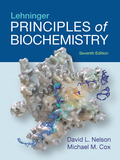
Concept explainers
(a)
To describe: The effect of increasing the distance between the leader peptide gene and sequence 2 on transcription of the E.coli trp operon.
Introduction:
Transcription attenuation is a mechanism which regulates the translation of a leader peptide by controlling the transcription of structural gene. Trp operon contains two trp codons at attenuator region that forms stem-loop structure. Sequence 1 encodes the leader peptide and sequence 2 is responsible for the constitutive expression.
(b)
To describe: The effect of increasing the distance between sequence 2 and sequence3 on transcription of the E.coli trp operon.
Introduction:
In the presence of tryptophan, occurrence of translation of leader sequences result in blocking the sequence 2. Blocking of sequence 2 followed by transcription of sequence 3 and sequence 4, and formation of attenuator structure.
(c)
To describe: The affect of removing sequence 4 on transcription of the E.colitrp operon.
Introduction:
In the presence of tryptophan, occurrence of translation of leader sequences result in blocking the sequence 2. Blocking of sequence 2 followed by transcription of sequence 3 and sequence 4, and formation of attenuator structure.
(d)
To describe: The effect of changing the two tryptophan (Trp) codons in the leader peptide gene to histidine (His) codons, on transcription of the E.coli trp operon.
Introduction:
Repressible operon represses the expression of structural gene. For example trp-operon have structural gene E, D, C, B and A that are repressed or inactive in the present of tryptophan. As the trp codon forms attenuation structure and make the operon sensitive against the tryptophan.
(e)
To describe: The effect of eliminating the ribosome-binding site for the gene that encodes the leader peptide on transcription of the E.coli trp operon.
Introduction:
Transcription attenuation is a mechanism which regulates the translation of a leader peptide by controlling the transcription of structural gene. Trp operon contains two trp codons at attenuator region that forms stem-loop structure. Sequence 1 encodes the leader peptide and sequence 2 is responsible for the constitutive expression
(f)
To describe: The effect of changing several nucleotides in sequence 3 so that it can base pair with sequence 4 but not with sequence 2, on transcription of the E.coli trp operon.
Introduction:
Transcription attenuation is a mechanism which regulates the translation of a leader peptide by controlling the transcription of structural gene. Trp operon contains two trp codons at attenuator region that forms stem-loop structure. Sequence 1 encodes the leader peptide and sequence 2 is responsible for the constitutive expression and sequence 3 and sequence 4 is responsible for the formation of attenuation structure.
Trending nowThis is a popular solution!

Chapter 28 Solutions
EBK LEHNINGER PRINCIPLES OF BIOCHEMISTR
- Using a cell of known pathlength b = 1.25115 x 10-3 cm, a water absorption spectrum was measured. The band at 1645 cm-1, assigned to the O-H bending, showed an absorbance, A, of 1.40. a) Assuming that water density is 1.00 g/mL, calculate the water molar concentration c (hint: M= mole/L) b) Calculate the molar absorptivity, a, of the 1645 cm-1 band c) The transmitted light, I, can be written as I= Ioexp(-xb), where x is the absorption coefficient (sometimes designated as alpha), Io is the input light, and b is the cell pathlength. Prove that x= (ln10)*x*c d) Calculate x for the 1645 cm-1 bandarrow_forwardConvert 1.38 eV into wavelength (nm) and wavenumber (cm-1) (c = 2.998 x 108 m/s; h = 6.626 x 10-34 J*s).arrow_forwardCan you help me understand the CBC method on metal bridging by looking at this problem?arrow_forward
- A partir de Aluminio y Co(NO3)2ꞏ6H2O, indicar las reacciones a realizar para obtener Azul de Thenard (Al2CoO4).arrow_forwardTo obtain Thenard Blue (Al2CoO4), the following reaction is correct (performed in an oven):Al(OH)3 + Co(OH)2 → Al2CoO4 + 4 H2Oarrow_forwardProblem 38 can u explain and solve thanks april 24arrow_forward
 ChemistryChemistryISBN:9781305957404Author:Steven S. Zumdahl, Susan A. Zumdahl, Donald J. DeCostePublisher:Cengage Learning
ChemistryChemistryISBN:9781305957404Author:Steven S. Zumdahl, Susan A. Zumdahl, Donald J. DeCostePublisher:Cengage Learning ChemistryChemistryISBN:9781259911156Author:Raymond Chang Dr., Jason Overby ProfessorPublisher:McGraw-Hill Education
ChemistryChemistryISBN:9781259911156Author:Raymond Chang Dr., Jason Overby ProfessorPublisher:McGraw-Hill Education Principles of Instrumental AnalysisChemistryISBN:9781305577213Author:Douglas A. Skoog, F. James Holler, Stanley R. CrouchPublisher:Cengage Learning
Principles of Instrumental AnalysisChemistryISBN:9781305577213Author:Douglas A. Skoog, F. James Holler, Stanley R. CrouchPublisher:Cengage Learning Organic ChemistryChemistryISBN:9780078021558Author:Janice Gorzynski Smith Dr.Publisher:McGraw-Hill Education
Organic ChemistryChemistryISBN:9780078021558Author:Janice Gorzynski Smith Dr.Publisher:McGraw-Hill Education Chemistry: Principles and ReactionsChemistryISBN:9781305079373Author:William L. Masterton, Cecile N. HurleyPublisher:Cengage Learning
Chemistry: Principles and ReactionsChemistryISBN:9781305079373Author:William L. Masterton, Cecile N. HurleyPublisher:Cengage Learning Elementary Principles of Chemical Processes, Bind...ChemistryISBN:9781118431221Author:Richard M. Felder, Ronald W. Rousseau, Lisa G. BullardPublisher:WILEY
Elementary Principles of Chemical Processes, Bind...ChemistryISBN:9781118431221Author:Richard M. Felder, Ronald W. Rousseau, Lisa G. BullardPublisher:WILEY





